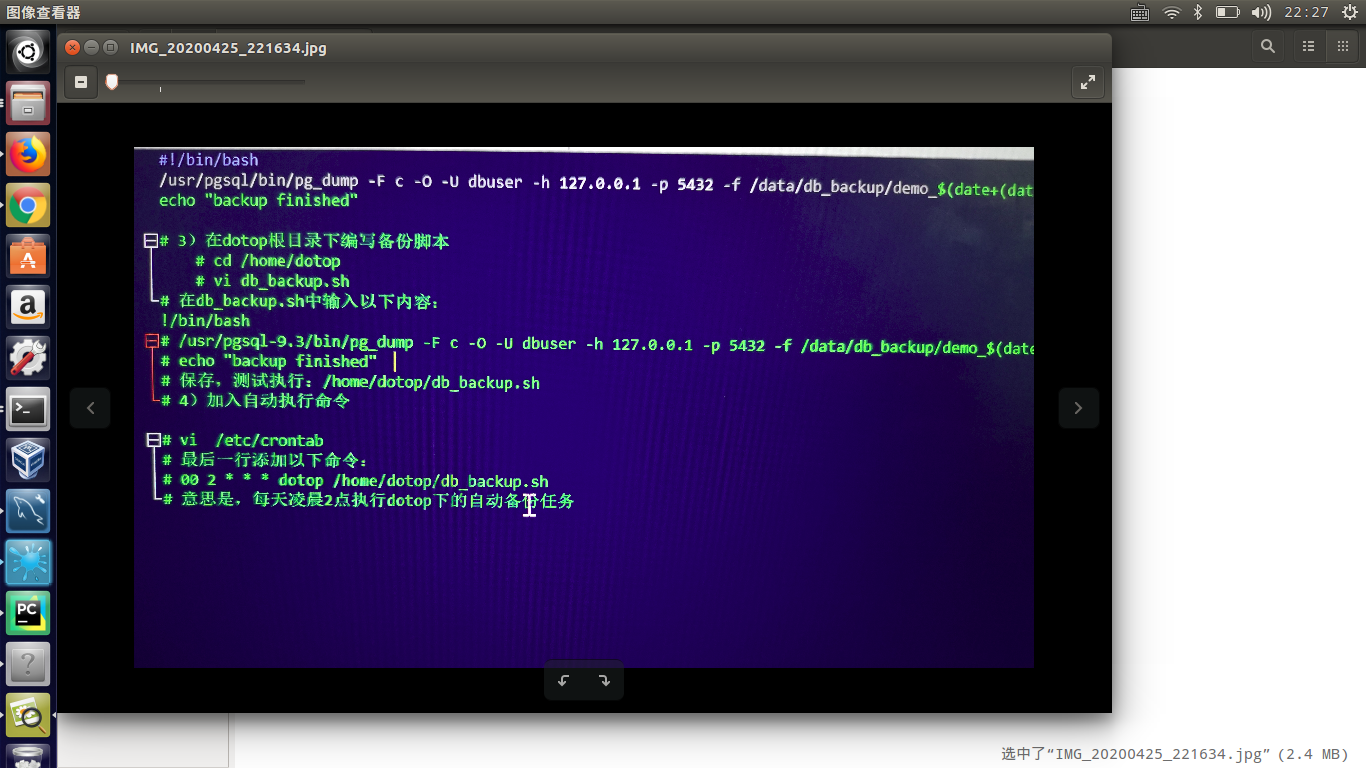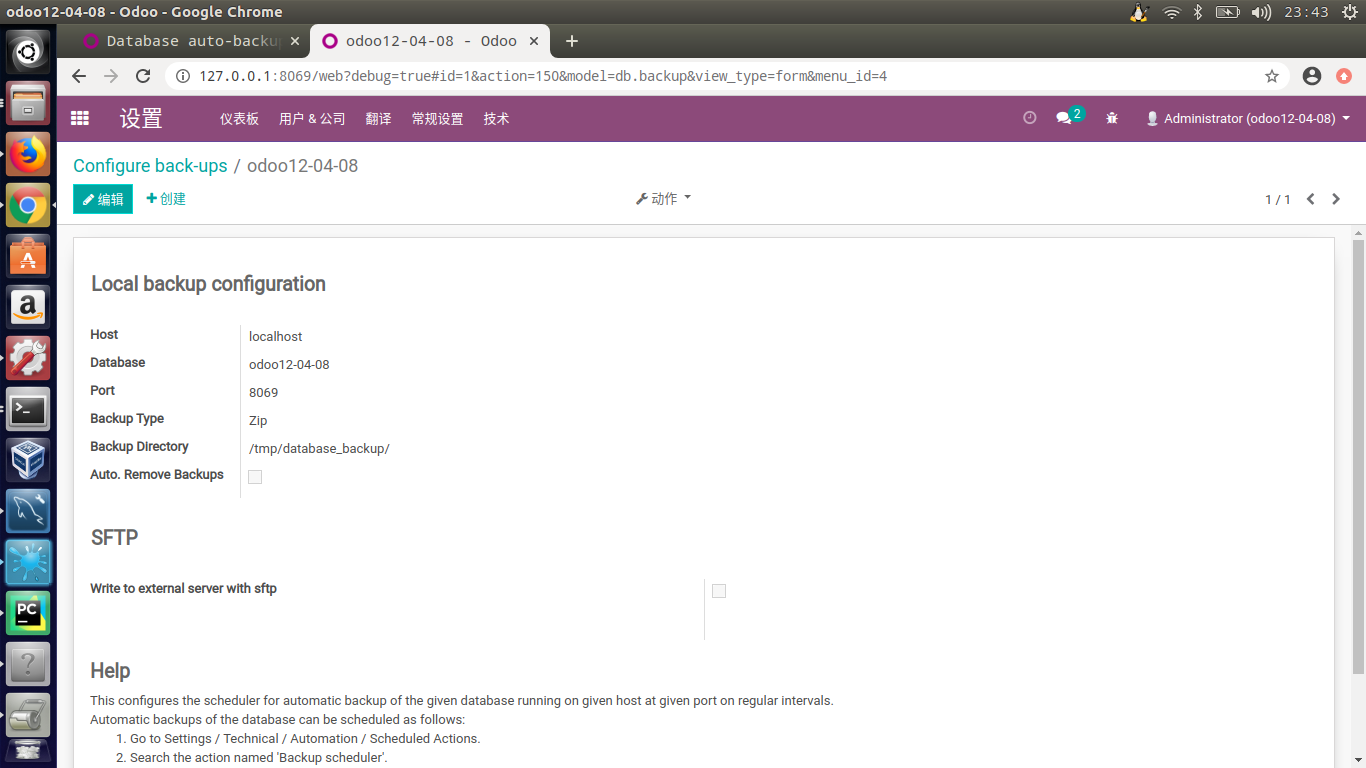流暢的pyhton4---數據庫備份
一、linux數據庫備份腳本
1、数据库备份,命令如下:
./pg_dump -h localhost -p 5432 -U postgres -W -F c -b -v -f "/opt/xxx.backup" xxx
2.在数据库安装目录bin下,./psql 进入数据库,输入密码,\c xxx(数据库名称) 进入指定数据库
\i 文件路径
postgresql數據庫:
备份:pg_dump -h localhost -p 5432 -U tradesns -W -F c -b -v -f "/home/tradeworkwangbin/us2010.backup" us2010恢复:pg_restore -h 127.0.0.1 -p 5432 -U postgres -W -d zjyj_gxversion -v "/opt/zjyj_gxversion_0410.backup"
db_backup.sh
#!/bin/bash
/usr/pgsql/bin/pg_dump -F c -O -U dbuser -h 127.0.0.1 -p 5432 -f /data/db_backup/demo_$(date+(date+%Y%m%d_%H_%M_%S).sql dotop
echo "backup finished"

二、python腳本備份數據庫
#!/usr/bin/env python3
# -*- coding: utf-8 -*-
"""
Created on Sat Apr 25 22:05:43 2020 @author: root
""" import os
import sys
import psycopg2
import time db_host='127.0.0.1'
db_port=5432
db_user='odoo'
db_password='odoo'
db_default='postgres'
backup_path="/usr/local/pgsql/dba/exp"
log_success="/usr/local/pgsql/dba/exp/log_success.txt"
log_error="/usr/local/pgsql/dba/exp/log_error.txt"
mail_list="xxxxx"
backup_day=time.strftime("%Y%m%d") def check_backup_path():
if not os.path.exists(backup_path):
os.mkdir(backup_path) def get_all_databases():
global databases
try:
conn=psycopg2.connect(host=db_host,port=db_port,user=db_user,password=db_password,database=db_default)
except BaseException as e:
with open(log_error,"a",encoding="utf-8") as f:
f.truncate()
f.write(str(e))
os.system("/bin/mailx -s '[Urgent]:Database on {0} connect failed, please check.' {1} < {2}".format(
db_host, mail_list, log_error))
else:
cur = conn.cursor()
cur.execute("select datname from pg_database where datname not in('template0','template1','postgres')")
rows = cur.fetchall()
for row in rows:
databases.append(list(row))
conn.close() def backup_all_databases():
global databases
try:
for database in databases:
db = str(database).replace('[', '').replace(']', '')
os.system("/usr/local/pgsql/bin/pg_dump --verbose --create {0} | gzip > {2}/{0}_{1}_sql.gz".format(
db, backup_day, backup_path))
with open(log_success, "a", encoding="utf-8") as f:
f.write("Database {0} backup finished...\n".format(db))
except BaseException as e:
with open(log_error, "a", encoding="utf-8") as f:
f.truncate()
f.write(str(e))
os.system("/bin/mailx -s '[Urgent]:Database {0} backup failed, please check.' {1}} < {2}".format(
db, mail_list, log_error))
else:
os.system("/bin/mailx -s 'All Database backup finished.' {0} < {1}".format(mail_list, log_success)) check_backup_path()
get_all_databases()
backup_all_databases()
三、odoo裏面備份數據庫
# -*- coding: utf-8 -*- from odoo import models, fields, api, tools, _
from odoo.exceptions import Warning
import odoo
from odoo.http import content_disposition import logging
_logger = logging.getLogger(__name__)
from ftplib import FTP
import os
import datetime try:
from xmlrpc import client as xmlrpclib
except ImportError:
import xmlrpclib
import time
import base64
import socket try:
import paramiko
except ImportError:
raise ImportError(
'This module needs paramiko to automatically write backups to the FTP through SFTP. Please install paramiko on your system. (sudo pip3 install paramiko)') def execute(connector, method, *args):
res = False
try:
res = getattr(connector, method)(*args)
except socket.error as error:
_logger.critical('Error while executing the method "execute". Error: ' + str(error))
raise error
return res class db_backup(models.Model):
_name = 'db.backup'
_description = 'Backup configuration record' @api.multi
def get_db_list(self, host, port, context={}):
uri = 'http://' + host + ':' + port
conn = xmlrpclib.ServerProxy(uri + '/xmlrpc/db')
db_list = execute(conn, 'list')
return db_list @api.multi
def _get_db_name(self):
dbName = self._cr.dbname
return dbName # Columns for local server configuration
host = fields.Char('Host', required=True, default='localhost')
port = fields.Char('Port', required=True, default=8069)
name = fields.Char('Database', required=True, help='Database you want to schedule backups for',
default=_get_db_name)
folder = fields.Char('Backup Directory', help='Absolute path for storing the backups', required='True',
default='/odoo/backups')
backup_type = fields.Selection([('zip', 'Zip'), ('dump', 'Dump')], 'Backup Type', required=True, default='zip')
autoremove = fields.Boolean('Auto. Remove Backups',
help='If you check this option you can choose to automaticly remove the backup after xx days')
days_to_keep = fields.Integer('Remove after x days',
help="Choose after how many days the backup should be deleted. For example:\nIf you fill in 5 the backups will be removed after 5 days.",
required=True) # Columns for external server (SFTP)
sftp_write = fields.Boolean('Write to external server with sftp',
help="If you check this option you can specify the details needed to write to a remote server with SFTP.")
sftp_path = fields.Char('Path external server',
help='The location to the folder where the dumps should be written to. For example /odoo/backups/.\nFiles will then be written to /odoo/backups/ on your remote server.')
sftp_host = fields.Char('IP Address SFTP Server',
help='The IP address from your remote server. For example 192.168.0.1')
sftp_port = fields.Integer('SFTP Port', help='The port on the FTP server that accepts SSH/SFTP calls.', default=22)
sftp_user = fields.Char('Username SFTP Server',
help='The username where the SFTP connection should be made with. This is the user on the external server.')
sftp_password = fields.Char('Password User SFTP Server',
help='The password from the user where the SFTP connection should be made with. This is the password from the user on the external server.')
days_to_keep_sftp = fields.Integer('Remove SFTP after x days',
help='Choose after how many days the backup should be deleted from the FTP server. For example:\nIf you fill in 5 the backups will be removed after 5 days from the FTP server.',
default=30)
send_mail_sftp_fail = fields.Boolean('Auto. E-mail on backup fail',
help='If you check this option you can choose to automaticly get e-mailed when the backup to the external server failed.')
email_to_notify = fields.Char('E-mail to notify',
help='Fill in the e-mail where you want to be notified that the backup failed on the FTP.') @api.multi
def _check_db_exist(self):
self.ensure_one() db_list = self.get_db_list(self.host, self.port)
if self.name in db_list:
return True
return False _constraints = [(_check_db_exist, _('Error ! No such database exists!'), [])] @api.multi
def test_sftp_connection(self, context=None):
self.ensure_one() # Check if there is a success or fail and write messages
messageTitle = ""
messageContent = ""
error = ""
has_failed = False for rec in self:
db_list = self.get_db_list(rec.host, rec.port)
pathToWriteTo = rec.sftp_path
ipHost = rec.sftp_host
portHost = rec.sftp_port
usernameLogin = rec.sftp_user
passwordLogin = rec.sftp_password # Connect with external server over SFTP, so we know sure that everything works.
try:
s = paramiko.SSHClient()
s.set_missing_host_key_policy(paramiko.AutoAddPolicy())
s.connect(ipHost, portHost, usernameLogin, passwordLogin, timeout=10)
sftp = s.open_sftp()
messageTitle = _("Connection Test Succeeded!\nEverything seems properly set up for FTP back-ups!")
except Exception as e:
_logger.critical('There was a problem connecting to the remote ftp: ' + str(e))
error += str(e)
has_failed = True
messageTitle = _("Connection Test Failed!")
if len(rec.sftp_host) < 8:
messageContent += "\nYour IP address seems to be too short.\n"
messageContent += _("Here is what we got instead:\n")
finally:
if s:
s.close() if has_failed:
raise Warning(messageTitle + '\n\n' + messageContent + "%s" % str(error))
else:
raise Warning(messageTitle + '\n\n' + messageContent) @api.model
def schedule_backup(self):
conf_ids = self.search([]) for rec in conf_ids:
db_list = self.get_db_list(rec.host, rec.port) if rec.name in db_list:
try:
if not os.path.isdir(rec.folder):
os.makedirs(rec.folder)
except:
raise
# Create name for dumpfile.
bkp_file = '%s_%s.%s' % (time.strftime('%Y_%m_%d_%H_%M_%S'), rec.name, rec.backup_type)
file_path = os.path.join(rec.folder, bkp_file)
uri = 'http://' + rec.host + ':' + rec.port
conn = xmlrpclib.ServerProxy(uri + '/xmlrpc/db')
bkp = ''
try:
# try to backup database and write it away
fp = open(file_path, 'wb')
odoo.service.db.dump_db(rec.name, fp, rec.backup_type)
fp.close()
except Exception as error:
_logger.debug(
"Couldn't backup database %s. Bad database administrator password for server running at http://%s:%s" % (
rec.name, rec.host, rec.port))
_logger.debug("Exact error from the exception: " + str(error))
continue else:
_logger.debug("database %s doesn't exist on http://%s:%s" % (rec.name, rec.host, rec.port)) # Check if user wants to write to SFTP or not.
if rec.sftp_write is True:
try:
# Store all values in variables
dir = rec.folder
pathToWriteTo = rec.sftp_path
ipHost = rec.sftp_host
portHost = rec.sftp_port
usernameLogin = rec.sftp_user
passwordLogin = rec.sftp_password
_logger.debug('sftp remote path: %s' % pathToWriteTo) try:
s = paramiko.SSHClient()
s.set_missing_host_key_policy(paramiko.AutoAddPolicy())
s.connect(ipHost, portHost, usernameLogin, passwordLogin, timeout=20)
sftp = s.open_sftp()
except Exception as error:
_logger.critical('Error connecting to remote server! Error: ' + str(error)) try:
sftp.chdir(pathToWriteTo)
except IOError:
# Create directory and subdirs if they do not exist.
currentDir = ''
for dirElement in pathToWriteTo.split('/'):
currentDir += dirElement + '/'
try:
sftp.chdir(currentDir)
except:
_logger.info('(Part of the) path didn\'t exist. Creating it now at ' + currentDir)
# Make directory and then navigate into it
sftp.mkdir(currentDir, 777)
sftp.chdir(currentDir)
pass
sftp.chdir(pathToWriteTo)
# Loop over all files in the directory.
for f in os.listdir(dir):
if rec.name in f:
fullpath = os.path.join(dir, f)
if os.path.isfile(fullpath):
try:
sftp.stat(os.path.join(pathToWriteTo, f))
_logger.debug(
'File %s already exists on the remote FTP Server ------ skipped' % fullpath)
# This means the file does not exist (remote) yet!
except IOError:
try:
# sftp.put(fullpath, pathToWriteTo)
sftp.put(fullpath, os.path.join(pathToWriteTo, f))
_logger.info('Copying File % s------ success' % fullpath)
except Exception as err:
_logger.critical(
'We couldn\'t write the file to the remote server. Error: ' + str(err)) # Navigate in to the correct folder.
sftp.chdir(pathToWriteTo) # Loop over all files in the directory from the back-ups.
# We will check the creation date of every back-up.
for file in sftp.listdir(pathToWriteTo):
if rec.name in file:
# Get the full path
fullpath = os.path.join(pathToWriteTo, file)
# Get the timestamp from the file on the external server
timestamp = sftp.stat(fullpath).st_atime
createtime = datetime.datetime.fromtimestamp(timestamp)
now = datetime.datetime.now()
delta = now - createtime
# If the file is older than the days_to_keep_sftp (the days to keep that the user filled in on the Odoo form it will be removed.
if delta.days >= rec.days_to_keep_sftp:
# Only delete files, no directories!
if sftp.isfile(fullpath) and (".dump" in file or '.zip' in file):
_logger.info("Delete too old file from SFTP servers: " + file)
sftp.unlink(file)
# Close the SFTP session.
sftp.close()
except Exception as e:
_logger.debug('Exception! We couldn\'t back up to the FTP server..')
# At this point the SFTP backup failed. We will now check if the user wants
# an e-mail notification about this.
if rec.send_mail_sftp_fail:
try:
ir_mail_server = self.env['ir.mail_server']
message = "Dear,\n\nThe backup for the server " + rec.host + " (IP: " + rec.sftp_host + ") failed.Please check the following details:\n\nIP address SFTP server: " + rec.sftp_host + "\nUsername: " + rec.sftp_user + "\nPassword: " + rec.sftp_password + "\n\nError details: " + tools.ustr(
e) + "\n\nWith kind regards"
msg = ir_mail_server.build_email("auto_backup@" + rec.name + ".com", [rec.email_to_notify],
"Backup from " + rec.host + "(" + rec.sftp_host + ") failed",
message)
ir_mail_server.send_email(self._cr, self._uid, msg)
except Exception:
pass """
Remove all old files (on local server) in case this is configured..
"""
if rec.autoremove:
dir = rec.folder
# Loop over all files in the directory.
for f in os.listdir(dir):
fullpath = os.path.join(dir, f)
# Only delete the ones wich are from the current database
# (Makes it possible to save different databases in the same folder)
if rec.name in fullpath:
timestamp = os.stat(fullpath).st_ctime
createtime = datetime.datetime.fromtimestamp(timestamp)
now = datetime.datetime.now()
delta = now - createtime
if delta.days >= rec.days_to_keep:
# Only delete files (which are .dump and .zip), no directories.
if os.path.isfile(fullpath) and (".dump" in f or '.zip' in f):
_logger.info("Delete local out-of-date file: " + fullpath)
os.remove(fullpath)

流暢的pyhton4---數據庫備份的更多相关文章
- python連接mysql數據庫
第一步,安裝mysql數據庫. 這裏我安裝的是mariadb數據庫,版本5.5,並且配置好了字符集.此處不詳細敘述,相信大家沒有問題. 第二步,安裝mysql驅動. 首先說明一下有兩個主要的驅動: m ...
- PB C/S轉B/S ODBC方式連接數據庫
PB C/S轉B/S ODBC方式連接數據庫,DSN需要建為系統而不是使用者DSN,否則連不上數據庫.
- 一次 C# 查詢數據庫 算法優化的案例
最近有次在修改某段程式時,發現一段程式算法看起來簡單. 但背後因為多次查詢數據庫,導致效能問題. 這段程式主要是利用 EPPLUS 讀取 Excel 資料,檢查資料是否已存在數據庫中,若有就將已存在的 ...
- 使用DataSet與DataAdapter對數據庫進行操作
1.定義連接字符串 var source = "server=(local); integrated security=SSPI; database=test"; var conn ...
- C#數據庫
一.連接數據庫 1.定義連接數據庫的字符串 string source = "server=(local); integrated security=SSPI; database=test& ...
- 在Android中afinal框架下實現sqlite數據庫版本升級的辦法
public abstract void onUpgrade(SQLiteDatabase db,int oldVersion,int new Version) 這個方法在實現時需要重寫. pub ...
- 數據庫ORACLE轉MYSQL存儲過程遇到的坑~(總結)
ORACLE數據庫轉MySQL數據庫遇到的坑 總結 最近在做Oracle轉mysql的工程,遇到的坑是真的多,尤其是存儲過程,以前都沒接觸過類似的知識,最近也差不多轉完了就總結一下.希望能幫到一些人( ...
- MVC+Ninject+三层架构+代码生成 -- 总结(一、數據庫)
一.數據表 是參照 別人的庫建表的 ,主鍵都是用int 自增,若是跨數據庫的話,建議使用GUID為主鍵.
- Scrapy——將數據保存到MySQL數據庫
Scrapy--將數據保存到MySQL數據庫 1. 在MySQL中創建數據庫表job_inf: 1 Create table job_inf( 2 id int(11) not null auto_i ...
随机推荐
- 【NX二次开发】Block UI 切换开关
属性说明 常规 类型 描述 BlockID String 控件ID Enable Logical 是否可操作 Group Logical ...
- 彻底解决Spring mvc中时间类型的转换和序列化问题
在使用Spring mvc 进行开发时我们经常遇到前端传来的某种格式的时间字符串无法用java8时间包下的具体类型参数来直接接收.同时还有一系列的序列化 .反序列化问题,在返回前端带时间类型的同样会出 ...
- MySQL的启动选项和系统变量该如何配置?
MySQL的配置信息可以通过两种方式实现,一种是命令行形式,在启动MySQL服务时后边带上相关配置参数,此种方式会在MySQL重启后失效.另外一种是通过写入配置文件,如my.cnf,启动或者重启MyS ...
- 使用python脚本统一重命名训练图片文件名
Yolo算法,在进行模型训练时,常常使用VOC数据格式. 将图片文件复制到JPEGImages目录下,需要对文件名进行VOC标准格式编号重命名,如2020_000001.jpg,2020_000002 ...
- Linux 中使用 QT Charts 显示温度传感器
前一篇笔记中实现了QT的Label控件显示CPU的温度,只能显示当前的温度,并不能反映CPU温度的变化情况,现在来实现使用QT Charts的曲线图实现一个实时曲线来显示CPU的温度. 添加对Qt C ...
- jQuery获取标签信息
<!DOCTYPE html><html><head> <meta charset="utf-8"/> <titl ...
- Redis 雪崩、穿透、击穿、并发、缓存讲解以及解决方案
1.缓存雪崩 数据未加载到缓存中,或者缓存同一时间大面积的失效,从而导致所有请求都去查数据库,导致数据库CPU和内存负载过高,甚至宕机. 比如一个雪崩的简单过程 1.redis集群大面积故障 2.缓存 ...
- SpringBoot缓存管理(一) 默认缓存管理
前言 Spring框架支持透明地向应用程序添加缓存对缓存进行管理,其管理缓存的核心是将缓存应用于操作数据的方法(包括增删查改等),从而减少操作数据的执行次数(主要是查询,直接从缓存中读取数据),同时不 ...
- mui 移动端网页双击事件处理
使用场景:需要在动态生成li列表数据中添加双击事件 定义事件 : var date1=null; function listdb(myKey) { var date2 = new Date(); if ...
- 使用 K6 来给你的服务做一次负载和压力测试吧
前言 负载测试,压力测试可以衡量服务是否是一个高可用,高性能的服务.负载测试能检验在不同的工作负荷下,服务的硬件消耗和响应,从而得到不同负载情况下的性能指标.压力测试能检验软硬件环境下服务所能承受的最 ...
